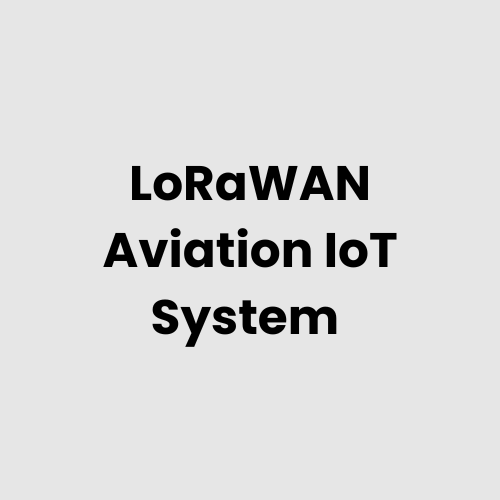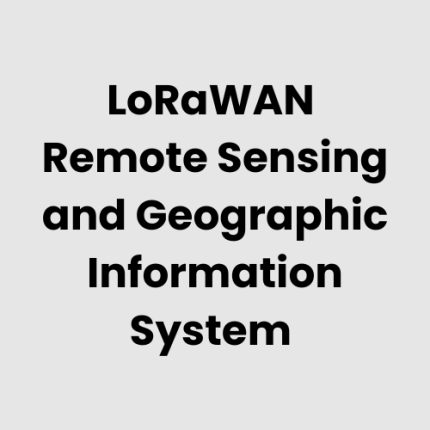Description
Technical Architecture of LoRaWAN Enabled Aviation IoT System
The LoRaWAN Enabled Aviation IoT System leverages long-range, low-power wide-area network (LoRaWAN) technology to provide real-time data transmission from various aviation assets, such as aircraft, drones, and ground equipment. The system architecture includes:
- IoT Sensors: Collect data from aircraft components, environmental conditions, and ground systems.
- Gateways: LoRaWAN gateways receive sensor data from the IoT devices and transmit it to the cloud or local servers.
- Network Server: Manages communication between gateways and devices, ensuring data packet integrity and encryption.
- Application Server: Processes the collected data, applying algorithms to provide real-time insights into aircraft performance, health, and operational conditions.
- Cloud Infrastructure: For scalable, secure data storage, analytics, and integration with other aviation management systems.
This structure ensures reliable, low-latency communication, offering aviation companies robust monitoring and tracking solutions.
List of Hardware for LoRaWAN Enabled Aviation IoT System
- IoT Sensors
-
- Environmental sensors (temperature, pressure, humidity)
- Aircraft health sensors (fuel monitoring, engine health, vibration, speed)
- Geospatial tracking sensors (GPS)
- LoRaWAN Gateways
- LoRaWAN base stations for data transmission between sensors and network server.
- Edge Computing Devices
- Embedded systems to pre-process data at the edge before sending it to the central servers.
- Aviation-Specific Communication Devices
- VHF/UHF radios for emergency and routine communication.
- Communication equipment integrated with aircraft avionics.
- Power Supply Systems
- Solar-powered or battery-operated solutions to ensure continuous operation in remote locations.
Physical Placement Considerations of the Hardware
- Sensors:
- Sensors are installed on various aircraft components and key ground infrastructure, ensuring real-time monitoring of aircraft health, environmental conditions, and operational performance.
- Sensors are placed in engine compartments, wings, and landing gears for real-time data collection on mechanical performance.
- Environmental sensors are positioned on aircraft fuselages or external positions for precise atmospheric measurements.
- Gateways: Gateways are strategically located at airports, air traffic control stations, and hangar facilities for maximum coverage of the LoRaWAN network.
- Edge Devices: Typically installed within aircraft cockpits or ground facilities to aggregate and pre-process data before transmitting it via LoRaWAN gateways to network servers.
- Power Supplies: Ensured to be efficient and resilient, especially for remote or offshore installations. Solar panels or high-capacity batteries are used to guarantee uptime in areas without reliable power sources.
Hardware Architecture of LoRaWAN Enabled Aviation IoT System
The LoRaWAN Enabled Aviation IoT System integrates several layers of hardware to ensure smooth data transmission and processing:
- On-board IoT Sensors: Collect environmental, operational, and mechanical data from aircraft systems.
- LoRaWAN Gateways: Act as communication hubs, gathering data from multiple sensors and relaying it to servers.
- Edge Computing Devices: Embedded devices that filter and process data locally before sending it over the network to central servers.
- Centralized Network Servers: Handle routing, security, and data validation.
- Cloud Data Storage & Processing: For data management, analysis, and actionable insights.
This layered approach enables efficient data flow, providing real-time actionable intelligence for aviation professionals to optimize operations, safety, and maintenance.
Deployment Considerations of LoRaWAN Enabled Aviation IoT System
- Network Planning: The deployment should take into account the geographic scope of the aviation operation, ensuring sufficient LoRaWAN gateway coverage to maintain constant connectivity across the airport, aircraft, and remote locations.
- Data Security: Implement end-to-end encryption between devices, gateways, and servers to protect sensitive aviation data.
- Integration: The system should integrate with existing aviation management platforms for a seamless workflow, including flight tracking, maintenance logs, and weather data systems.
- Scalability: The system must be flexible and scalable to accommodate the growth of the fleet or the expansion of the IoT network as more sensors and aircraft are added.
- Compliance with Aviation Regulations: Ensure compliance with global aviation standards such as the FAA (Federal Aviation Administration) in the U.S. and ICAO (International Civil Aviation Organization) for operational safety.
List of Relevant Industry Standards and Regulations
- ICAO (International Civil Aviation Organization) Standards
- FAA (Federal Aviation Administration) Regulations
- EU EASA (European Union Aviation Safety Agency) Regulations
- RTCA DO-178C (Software Considerations in Airborne Systems and Equipment Certification)
- ISO/IEC 27001 (Information Security Management Systems)
- LoRaWAN Network Protocol Specifications (LoRa Alliance)
Local Server Version (Running with a Local Server)
A LoRaWAN Enabled Aviation IoT System can be deployed with a local server configuration where all data processing, analytics, and storage occur on-premises. This is ideal for operations requiring quick, local insights or when cloud connectivity is limited.
- Local Data Management: Ensures faster data processing and real-time analytics, with minimal latency in data transmission and retrieval.
- Data Redundancy: Backup systems can be integrated into the local server to ensure data continuity in the event of a failure.
- Custom Analytics and Reporting: Local servers provide the flexibility to design customized reports and analytics according to the specific needs of the aviation company.
Cloud Integration and Data Management
The LoRaWAN Enabled Aviation IoT System can also integrate with cloud platforms for global data access, storage, and advanced analytics. Cloud integration allows aviation companies to:
- Access Data Remotely: View real-time and historical data from anywhere, allowing for global fleet management.
- Advanced Data Analytics: Leverage machine learning models to predict aircraft health, optimize fuel consumption, and improve operational efficiency.
- Scalability: Cloud infrastructure offers the flexibility to scale operations, whether it’s adding new aircraft, sensors, or gateways.
- Data Security and Compliance: Cloud platforms provide robust security measures to ensure aviation data complies with international regulations and industry standards.
GAO Case Studies of LoRaWAN Enabled Aviation IoT System
- Los Angeles, California
In Los Angeles, the integration of a LoRaWAN-enabled IoT system in aircraft has helped improve operational efficiency by tracking aircraft components in real-time. The system collects data from engine health sensors, fuel levels, and environmental conditions, providing maintenance teams with critical insights to reduce downtime and improve aircraft reliability.
- New York City, New York
In New York City, a major airport implemented a LoRaWAN-enabled aviation IoT system to monitor ground operations. The system tracks cargo loading, baggage handling, and aircraft servicing in real-time, ensuring efficient airport management. This connected system has improved coordination, reduced delays, and enhanced safety protocols across various terminal activities.
- Chicago, Illinois
Aviation companies in Chicago use LoRaWAN-based IoT devices to track aircraft location and performance during taxiing and flight. This real-time data, collected from various aircraft sensors, is transmitted to ground control, helping reduce congestion on runways and providing valuable data for predictive maintenance, preventing issues before they impact operations.
- Houston, Texas
Houston’s airport utilizes LoRaWAN-enabled IoT systems to streamline air traffic management. By connecting sensors in aircraft and ground stations, the system ensures optimal routing of aircraft on runways, reducing delays caused by weather conditions and congestion, and improving the overall airport efficiency.
- San Francisco, California
In San Francisco, LoRaWAN technology is employed in fleet management for maintenance, using IoT sensors to monitor the health of aircraft engines. The data collected allows ground teams to anticipate parts needing attention, significantly reducing maintenance costs and improving the safety of operations.
- Denver, Colorado
LoRaWAN-enabled IoT systems in Denver have transformed how aircraft components
are monitored, from fuel consumption to engine wear. Real-time data allows for more accurate predictive analytics and early identification of mechanical issues, reducing emergency maintenance and increasing fleet uptime for aviation companies.
- Seattle, Washington
Seattle’s aviation sector has embraced LoRaWAN-enabled IoT devices to monitor weather and atmospheric conditions around airports. Sensors deployed on the tarmac provide real-time updates on weather changes, allowing air traffic control to adjust flight paths and prevent delays caused by sudden weather shifts, such as fog or storms.
- Miami, Florida
In Miami, aviation companies have deployed LoRaWAN IoT sensors to monitor cargo and baggage handling systems. By tracking baggage location and temperature in real-time, the system ensures the safe and timely delivery of cargo, improving efficiency while maintaining high safety standards for sensitive goods.
- Atlanta, Georgia
Atlanta’s airports have implemented a LoRaWAN-based IoT system for smart baggage management. Using IoT sensors placed on baggage carts, the system tracks luggage from check-in to loading, reducing the likelihood of misplaced luggage and improving passenger satisfaction by enhancing baggage handling efficiency.
- Boston, Massachusetts
Boston’s airport adopted LoRaWAN-enabled IoT technology for aircraft fueling systems. The system tracks fuel levels, flow rates, and delivery times, helping optimize fuel management operations and reducing errors that could lead to costly delays or refuelling inefficiencies.
- Washington, D.C.
Washington D.C. airports utilize LoRaWAN-enabled IoT systems to monitor runway and taxiway conditions. Ground sensors report real-time updates on surface conditions, such as ice or debris, allowing air traffic controllers to act quickly and prevent potential accidents caused by runway hazards.
- Dallas, Texas
In Dallas, LoRaWAN technology is used to track the health of aviation battery systems used in aircraft emergency backup systems. The IoT sensors collect data on charge levels and battery performance, sending alerts if any issues are detected, which ensures that aircraft are always equipped with functional backup systems.
- Phoenix, Arizona
Phoenix has adopted a LoRaWAN-enabled IoT solution for temperature-controlled cargo. Using sensors to monitor temperature fluctuations throughout transport, the system helps ensure perishable goods are kept within safe temperature ranges, improving supply chain visibility and reducing spoilage.
- Detroit, Michigan
LoRaWAN-based IoT solutions in Detroit enable real-time monitoring of aircraft tire pressure and wear. This proactive maintenance solution has significantly reduced unscheduled groundings and enhanced safety by allowing for timely tire replacements and repairs based on real-time sensor data.
- Orlando, Florida
In Orlando, LoRaWAN-enabled IoT systems are utilized to monitor the health and performance of drone fleets used for aerial inspections. Real-time data from the drones’ on-board sensors are transmitted to ground stations, providing operators with essential insights into drone battery life, navigation accuracy, and environmental conditions.
Canada Case Studies
- Toronto, Canada
In Toronto, LoRaWAN-enabled IoT systems have been employed to monitor aircraft landing gear performance. Sensors embedded within the gear provide continuous data regarding wear and tear, ensuring that any potential issues are detected before they lead to costly repairs or flight delays.
- Vancouver, Canada
Vancouver uses LoRaWAN technology in aviation to monitor air quality and pollution levels in and around the airport. IoT sensors track environmental factors such as carbon emissions and air particulate matter, helping improve sustainability efforts while ensuring that airport operations comply with environmental regulations.
Navigation Menu for LoRaWAN
Navigation Menu for IoT
- LORAWAN
- ZIGBEE
- Wi-Fi HaLow
- Z-WAVE
- BLE & RFID
- NB-IOT
- CELLULAR IOT
- GPS IOT
- IOT SENSORS
- EDGE COMPUTING
- IOT SYSTEMS
Our products are in stock and can be shipped anywhere in the continental U.S. or Canada from our local warehouse. For any further information, please fill out this form or email us.
We are actively looking for partners who are like us located in the U.S. and Canada. For more information on partnering with GAO, please visit Partner with GAO Tek Inc. It lists various ways to partner with GAO, such as OEM Partnerships, Technology Integration, Distribution and Reselling Opportunities, Presenting at the Leading Event Tek Summit, Joint R&D Projects, Training and Consulting Services, Industry-Specific Collaborations, Research and Academic Partnerships.



